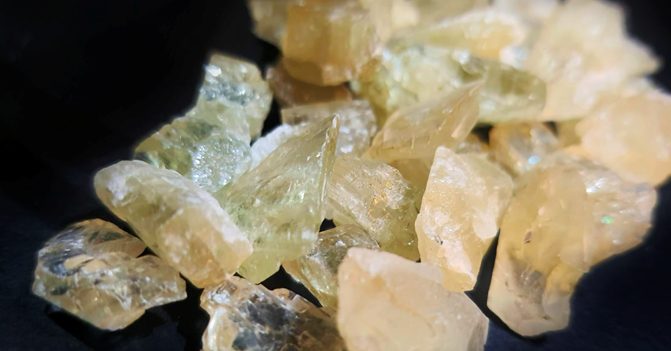Lithium has been the subject of a global race in recent years between countries such as Chile, Argentina, Australia and China, which lead the production of the mineral. This is due to the increasing demand in the manufacturing of lithium-ion batteries that power electronic devices, electric cars, and renewable energy storage systems.
Brazil has great potential for lithium exploration, especially in the Jequitinhonha Valley, in Minas Gerais, where the country's largest reserves are located. Last week, the Brazilian Mining Institute (IBRAM), the government of Minas Gerais and the Ministry of Mines and Energy (MME) created the "Lithium Valley" initiative, to attract international investments in the creation of a hub for exploration and industrialization of the mineral in the region. The region has aroused the interest of two mining companies listed on the Nasdaq (National Association of Securities Dealers Automated Quotations), the second largest stock exchange in the world. These miners are Sigma Lithium (NASDAQ: SGML) and Atlas Lithium (NASDAQ: ATLX). In addition, other companies are also developing projects in the region, such as Lithium Ionic (TSX: LTH), listed on the Toronto Stock Exchange, Latin Resources (ASX: LRS), listed on the Australian Stock Exchange, and Companhia Brasileira de Lithium (CBL). The goal is to transform the region into one of the main producers of lithium in the world.
OVERVIEW OF LITHIUM IN BRAZIL
In Brazil, pegmatites are the main source of lithium, found in the crystal structure of some minerals. From these minerals, lithium is concentrated in the form of lithium hydroxide () and lithium carbonate (). Lithium carbonate is mainly used in aluminum production and the glass industry. Lithium hydroxide, on the other hand, is used in the production of lithium-ion batteries and lubricating greases.
According to data from the United States Geological Survey's (USGS) 2023 Mineral Commodity Summary report, Brazil is responsible for 1.7% of the world's lithium production and approximately 1% of the world's reserves. Brazilian reserves are concentrated mainly in Minas Gerais (in the Jequitinhonha Valley), Ceará, Rio Grande do Norte, Paraíba, Tocantins, Goiás and Bahia.

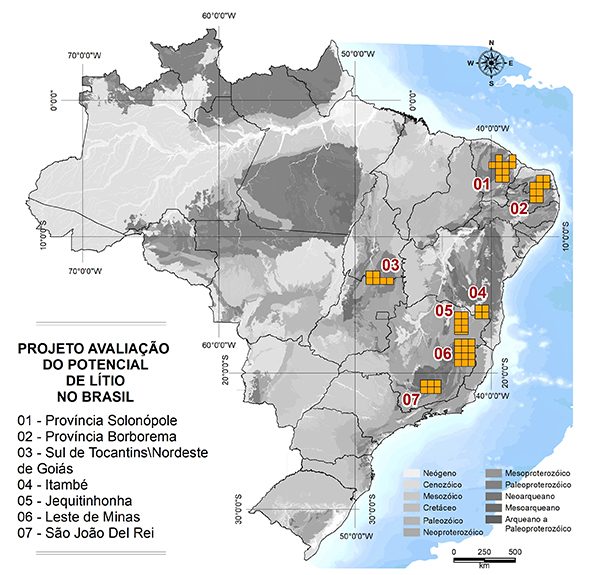


One of the largest active lithium mines in Brazil is owned by Companhia Brasileira de Lithium (CBL), which operates its underground mine, called Mina da Cachoeira, located in Araçuaí — Minas Gerais. Litiniferous Pegmatite is extracted there, which is processed until it becomes spodumene concentrate. The extraction of the ore is carried out through the sublevel stopping method. Currently, the galleries of the Cachoeira Mine reach up to 180 m deep and up to 5 km long. The ploughing is carried out in retreat, that is, from the ends of the body to the center of the level, where the cross-cut connecting the gallery and the ramp is positioned. The production capacity is 30 thousand tons per year and the chemical plant is located in the municipality of Divisa Alegre, about 180 km away from the Cachoeira Mine.
Until 2022, only two companies produced lithium in Brazil: Companhia Brasileira de Lithium (CBL) and AMG Brasil. However, in 2023, Brazil entered the lithium battery market for good, with emphasis on Sigma Lithium, which started production at the Grota do Cirilo mine, in Vale do Jequitinhonha (MG). The company expects to produce 270,000 tons per year of lithium for batteries and increase to 768,000 tons in the second year of the project.




The regions highlighted on the map are located in the place that recently began to be recognized as "Lithium Valley", characterized by the presence of the highest concentrations of lithium in Brazil. This fact has attracted the interest of several companies, both national and multinational, which are investing significantly in mineral exploration and research in search of deposits. Some companies that are prospecting in the region are Companhia Brasileira de Lithium (CBL), Sigma Lithium, Latin Resources, Atlas Lithium and Lithium Ionic. With the discovery of several deposits, the region is now inserted in the global competition for lithium.
Lithium in the north of Minas Gerais
The lithium deposits of the north and northeast of the state of Minas Gerais are associated with pegmatites found in the Eastern Brazilian Pegmatite Province, in particular in the Pegmatite District of Araçuaí. Spodumene is the predominant mineral, presenting several varieties and being associated with five stages of crystallization in pegmatitic evolution. Stage I, which is the main stage for industrial purposes, is formed at higher temperatures (700 – 350 °C), while the secondary stages develop at lower temperatures (350 – 50 °C).
According to data from the National Mining Agency, the municipalities of Araçuaí and Itinga, in the Jequitinhonha Valley, have 136 processes of applications for research authorization and mining concession for lithium. These two cities account for approximately 21% of all lithium research requests registered in the state of Minas Gerais as of April 2023.




The presence of large investments in the Jequitinhonha Valley can provide several benefits to this region, which is one of the poorest and poorest in the country. For example, Sigma Lithium plans to invest around R$ 3 billion in its green lithium project and three other companies (Latin Resources, Lithium Ionic, Atlas Lithium) are expected to invest around R$ 1.5 billion in projects in the cities of Salinas, Araçuaí and Itinga.


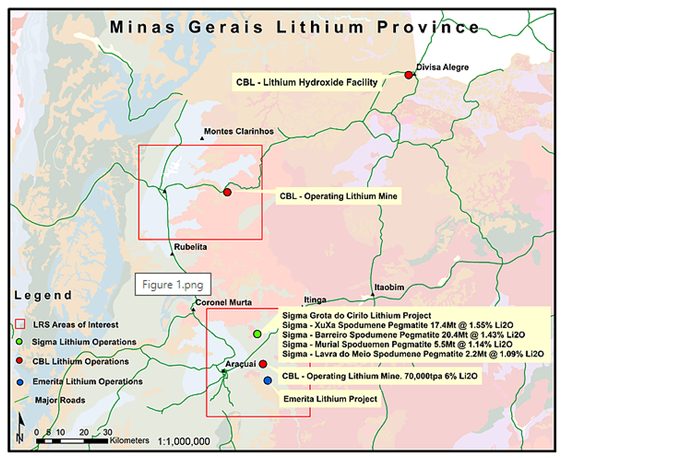

The lithium market in the region has been buoyant in recent months, especially following the acquisition of Neolit Minerals by Lithium Ionic (TSX: LTH. V). The Canadian company, listed on the Toronto Stock Exchange, acquired 100% of Neolit Minerals in March of this year. Neolit Minerals controls 40% of the Salinas project in Minas Gerais, and Lithium Ionic has the right to increase its stake to up to 85% upon the fulfillment of certain mineral exploration commitments. In addition, Sigma Lithium announced last month that it has successfully and safely completed the commissioning of Phase 1 of its Greentech Plant at the Grota do Cirilo project. This allowed it to obtain the first production of Green Lithium in the region, representing an important milestone for the company and for the lithium market in Brazil.
NEW LITHIUM PROJECTS IN BRAZIL
Applications for research authorization for lithium went from 35 in 2017 to 417 in November 2022. According to the Brazilian Mineral Yearbook, the total number of processes for research authorization and mining concession in Brazil reached 1079 in April 2023.




In the map above, a significant portion of the processes is located in the north of Minas Gerais, which is the leading state in lithium production in Brazil. In this context, we can highlight some projects under development in Minas Gerais, such as Atlas Lithium, which develops and advances its lithium in hard rock project, which consists of 52 mineral rights spread over 227 km², around the municipality of Araçuaí, in Minas Gerais. In addition, the company owns 100% of a second lithium project located in the states of Paraíba and Rio Grande do Norte.




In 2022, Australian company Latin Resources (ASX: LRS) raised A$35 million to invest in the Salinas Lithium project. This project, located in the north of Minas Gerais, comprises two prospecting areas: Vale do Bananal, with 1,250 hectares; and Salinas Sul, with 4,088 hectares. Also in 2022, a new lithium discovery was announced in the Salinas project. According to the company, the latest results of the diamond drilling campaign at the site confirmed several pegmatites containing a high lithium content.
In 2023, Lithium Ionic, a Canadian mineral exploration company, entered into a contract with Clésio Alves Gonçalves Mineração e Comércio for the purchase of lithium mining rights on land in the Jequitinhonha Valley, in Minas Gerais. The acquisition, which covers about 1,000 hectares, is considered strategic for Lithium Ionic, which now has a total area of 7,700 hectares in land for drilling and research.
In the central region of Minas Gerais, between the municipalities of Nazareno and São Tiago, with a mine in Volta Grande, AMG produces lithium associated with tantalum, enabling the exploration of two minerals in a single rock. In addition, the company has an advance sale contract for 200 thousand tons of lithium concentrate over the next five years. The planned investment is R$ 838.9 million.
Bahia has also been standing out, as the largest Chinese producer of electric vehicles, BYD, announced that it plans to implement a lithium and iron phosphate processing unit in the state, in order to manufacture batteries, with production expected to start in 2024.
One of the factors that can boost lithium production in Brazil is Decree No. 11,120 announced by the federal government on July 5, 2022, which allows for the flexibility of foreign trade of the mineral. The decree waives the authorization of the National Nuclear Energy Commission (CNEN) for the export of lithium, correcting a distortion that came from the 70s, when the mineral was considered of nuclear interest. With this change, Brazil will continue to attract several foreign companies to mining in the country.
WORLD LITHIUM OVERVIEW
There are three categories of economically viable lithium deposits: pegmatites, continental evaporite brines, and hectorite clays. The most relevant deposits are evaporite brines, containing the world's largest lithium reserves, and pegmatites, characterized by several lithium minerals such as lepidolite, amblygonite, petalite and spodumene, which have a well-established processing chain and varied global distribution.
According to the United States Geological Survey, the countries with the largest lithium resources are: Bolivia, with 21 million tons, followed by Argentina, with 20 million and Chile, with 11 million, together, these three countries form the lithium triangle, in addition to these three countries there is also the United States with 12 million tons.
In 2022, operations in Australia (61000 ton), Chile (39000 ton), China (19000 ton), Argentina (6200 ton) and Brazil (2200 ton) accounted for the majority of the world's lithium production. In addition, smaller operations in Canada (500 tonnes), Portugal (600 tonnes) and Zimbabwe (800 tonnes) also contributed to the world's lithium production, as we can see in the table below.




According to the United States Geological Survey (USGS-2023) report, identified lithium resources have increased substantially worldwide and total about 98 million tons, of which 730 thousand tons are located in Brazil.
The global lithium market is expanding and several countries are investing in research in the search for new deposits. In March, Iran announced the discovery of a reserve that could make the country the fourth largest holder of lithium reserves in the world, if initial estimates are confirmed. Located in Qahavand, Hamadan province, the deposit has the potential to generate 8.4 million tons of lithium, However, the government has not yet revealed which companies will be the first to explore the region.




Lithium supply has become a priority for technology companies in Asia, Europe, and the United States. Therefore, strategic alliances between technology companies and mining companies are being established to ensure reliable and diversified lithium production for battery suppliers and vehicle manufacturers.
Lithium Triangle
Situated in the Andean Altiplano, between the mountain ranges of the Andes in the east and west, in northern Chile, Argentina and part of Bolivia, lies the so-called Lithium Triangle, an area that is home to more than half of the world's lithium reserves. The main lithium deposits are found in the Salar de Uyuni in Bolivia, the Salar de Atacama in Chile, and the Salar del Hombre Muerto in Argentina.

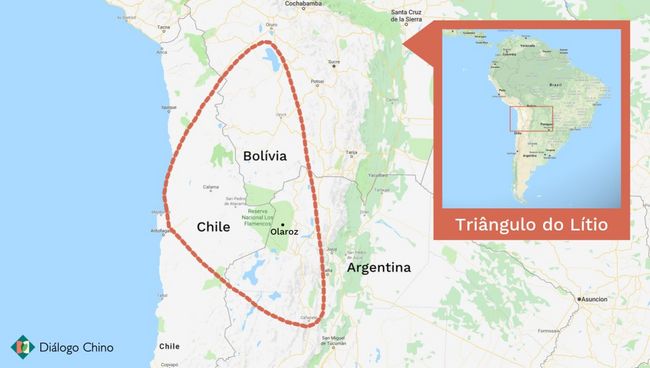
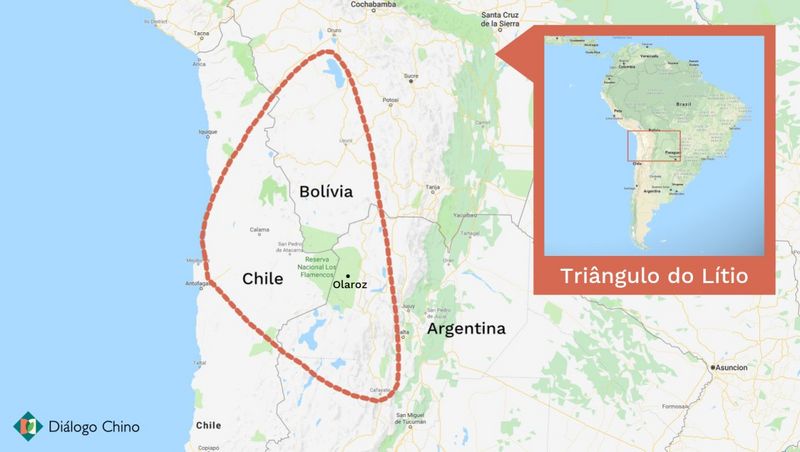
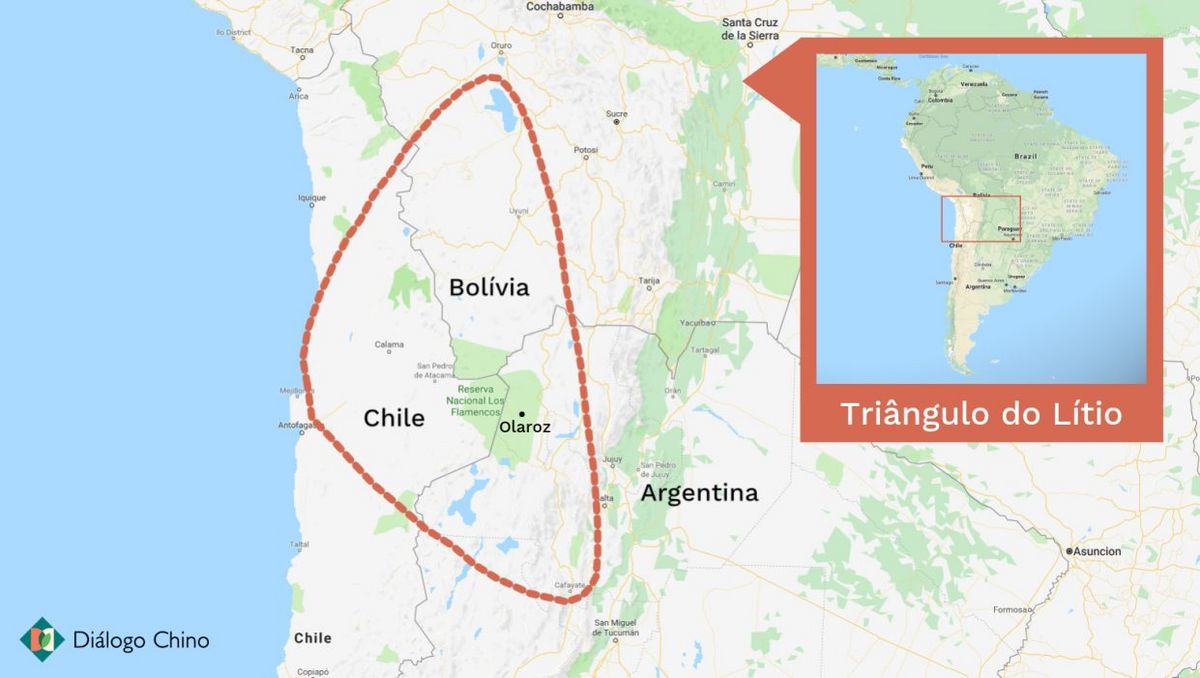
The extraction of lithium in the triangle takes place in salt flats located in the Atacama Desert region and adjacent areas. The extraction process begins with the drilling of the salt crust and the subsequent extraction of brine, which is then taken to evaporation pools. During this process, the brine is exposed to evaporation for months, creating a salty sludge that contains a mixture of various elements, including manganese, potassium, borax, and lithium salts.




This mixture is transferred to another outdoor evaporation pool, where, after a period of 12 to 18 months, it is distilled to extract lithium carbonate, the main raw material used in the manufacture of lithium-ion batteries.
This large concentration of lithium in South America has been drawing the attention of the United States and China. The two powers have been seeking to obtain strategic metals for the energy transition. In addition, more and more Chinese companies are advancing in South America with large investments in mining, driving the growth of the "triangle" countries in the sector.
Nationalization of lithium
With the significant increase in demand for lithium in recent years, many countries with reserves of this mineral are taking steps to nationalize their production. This allows these countries to have greater control over their resources and lithium production. Some countries have already begun the process of nationalizing production, including Bolivia, Chile and Mexico.
Bolivia: Its lithium nationalization process began in 2008, during the government of President Evo Morales. The measure was part of a policy to recover the country's natural resources. In 2017, the government created a state-owned company especially dedicated to the sector, YLB (Yacimientos de Lithium Bolivianos). In 2023, YLB closed an agreement with a consortium of Chinese companies to explore, refine and process lithium, in addition to producing batteries from 2025. Bolivia is the country with the largest lithium resources, however, it is not yet among the world's largest producers.
Mexico: In April 2022, the Mexican Congress approved a reform of the law that declares lithium as a national heritage and prohibits new private concessions to explore the mineral. The reform also establishes that the exploration and use of lithium will be the exclusive responsibility of the State, through a state-owned company. However, these measures generate uncertainty about the possibility of the government expropriating companies already operating in the country.
Chile: Chile's President Gabriel Boric recently announced a plan to nationalize its lithium industry. The plan foresees that the State will become the main agent of the national market, through the state-owned company Codelco. The company will be responsible for all initiatives for lithium production in the country, through public-private partnerships. In new exploration projects, the government should be the majority operator, that is, have more than 50% of the operation. Existing contracts with private companies will continue to be valid until they expire, and companies will be able to renew them as long as they include the State in the business.
The nationalization of lithium involves major challenges and risks, both for lithium producing and consuming countries. One of the main challenges is the high investment cost required to develop the lithium production chain, from extraction to the manufacture of batteries and other products. State-owned companies created by countries do not always have enough resources to invest in this sector. In addition, the nationalization of lithium may generate uncertainties for private companies that already operate in these countries, especially in Chile, which is the second largest producer in the world. These companies may face difficulties in renewing their concessions or having to pay higher royalties to the State. Nationalization could also provoke a negative reaction from consumer countries, especially those leading the electric vehicle industry, such as China and the United States, which could end up in a search for alternative sources of lithium in countries such as Brazil and Australia, which still have no plans to nationalize lithium production.
FUTURE PROSPECTS FOR LITHIUM
Increasing demand for electric vehicles worldwide is expected to continue driving the lithium market in the coming years, and more manufacturers are seeking reliable sources of feedstock for their batteries. Another important factor for future prospects is the growing importance of renewable energy worldwide.
As the demand for renewables increases, the demand for lithium batteries for energy storage is also expected to increase, opening up new opportunities for the market.
Several countries are investing in subsidies for the energy transition, to enable sustainable development with the use of renewable energies. In addition, World Bank estimates indicate that the demand for lithium could grow by 965% by 2050, further increasing the prospects and opportunities for companies and countries that have large lithium deposits.
Want to know more about lithium? Read here the article made by DMT about the characteristics of this important element.
Sources:
https://www.brasilmineral.com.br/noticias/sigma-lithium-inicia-producao-do-seu-litio-verde-em-mg
http://www.sgb.gov.br/litio/nomundo.html
https://diariodocomercio.com.br/economia/amg-investira-r-12-bi-em-planta-de-litio-em-minas-gerais/
https://repositorio.ipea.gov.br/bitstream/11058/10603/1/Radar_impacto_novas_tecnologias_litio.pdf
https://www.inthemine.com.br/site/cenarios-do-litio-no-brasil/
https://cblitio.com.br/mineracao/
https://pubs.usgs.gov/periodicals/mcs2023/mcs2023-lithium.pdf
https://minerabrasil.com.br/sigma-lithium-inicia-producao-mina-grota-do-cirilo/
https://diariodocomercio.com.br/economia/nacionalizacao-do-litio-no-chile-gera-incertezas/
